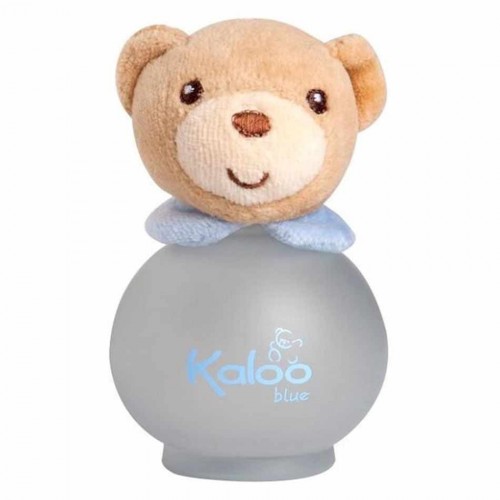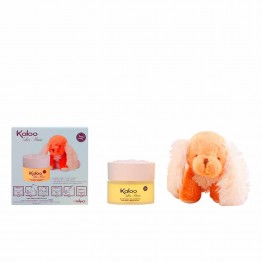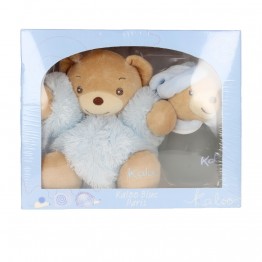Kaloo perfume Blue
agua perfumada sem álcool para menino, foi lançado em 2001. as notas de topo são bergamota e tanherina, as notas de coração são flor de laranjeira e madressilva, a nota de fundo é almíscar

Kaloo, uma história de paixão francesa, oferece a crianças e adultos mundos suaves e encantadores que atendem às suas necessidades em termos de despertar, ternura e segurança.
1998: Criação da marca Kaloo
Combinação de dois valores essenciais da marca: Câlin e Doux, que formam o nome CALOUX = KALOO. É um ursinho, um símbolo emocional querido por crianças pequenas, eleito como um animal emblemático. Com a sua barriguinha redonda na qual gostamos de mergulhar os dedos, dois olhos curiosos e uma suavidade incomparável, chamamos-lhe “Patapouf”: será o ícone da marca
2000: Kaloo viaja pelo mundo
Depois de entrar com sucesso no mercado europeu com uma linha de produtos de alta qualidade e materiais altamente técnicos, a Kaloo se firma como uma marca de referência no mundo dos presentes de nascimento. A Kaloo então fortaleceu seu posicionamento no mundo e embarcou na aventura americana com a Kaloo North America.
2001: Kaloo ganha velocidade
Na primavera de 2001, nasceu Kaloo Parfums: um véu de suavidade perfumada com quatro águas aromáticas especialmente criado para despertar os sentidos olfativos das crianças. Águas perfumadas com notas doces e frescas, sem álcool e clinicamente testadas.
Menino
Perfumes para Crianças Meninos: Fragrâncias Aventureiras e Divertidas para os Pequenos Aventureiros
Os perfumes podem ser uma maneira divertida e emocionante de adicionar um toque especial à rotina de cuidados pessoais das crianças meninos. Escolher um perfume adequado para os pequenos aventureiros com idades entre 3 e 10 anos é essencial. Neste artigo, vamos explorar a importância de selecionar perfumes seguros e empolgantes para as crianças meninos, além de fornecer dicas úteis para garantir uma experiência perfumada agradável.
1. Fragrâncias frescas e cítricas:
Ao escolher perfumes para crianças meninos, é recomendável optar por fragrâncias frescas e cítricas. Essas notas revigorantes são perfeitas para energizar os pequenos aventureiros e complementar seu espírito animado. Fragrâncias com toques de hortelã, limão ou bergamota são opções populares.
2. Perfumes especialmente formulados para crianças:
Procure por perfumes que sejam especificamente formulados para crianças. Esses produtos são desenvolvidos levando em consideração a pele delicada e sensível das crianças, evitando ingredientes agressivos. Certifique-se de que os produtos sejam hipoalergênicos e seguros para uso em crianças, verificando sempre os rótulos.
3. Embalagens atraentes e aventureiras:
As embalagens dos perfumes para crianças meninos desempenham um papel importante na escolha. Opte por frascos com designs atrativos e aventureiros, como personagens de super-heróis, carros ou elementos relacionados à natureza. Embalagens envolventes e divertidas podem despertar o interesse dos meninos e tornar a experiência perfumada ainda mais empolgante.
4. Aplicação moderada:
Ensine às crianças a importância de usar perfumes com moderação. Instrua-as a aplicar uma quantidade mínima em áreas específicas, como os pulsos ou a parte de trás das orelhas. Dessa forma, elas podem desfrutar da fragrância sutil sem sobrecarregar seus sentidos ou os das pessoas ao seu redor.
5. Envolvimento dos pais:
Os pais desempenham um papel fundamental na escolha e uso adequado dos perfumes para crianças meninos. Certifique-se de acompanhar o uso dos perfumes e orientar as crianças sobre a aplicação correta e responsável. Além disso, é importante lembrar que crianças nessa faixa etária ainda estão em desenvolvimento e devem ser supervisionadas ao usar produtos perfumados.
Conclusão:
Os perfumes para crianças meninos podem adicionar um toque emocionante à rotina de cuidados pessoais dos pequenos aventureiros, permitindo-lhes explorar o mundo das fragrâncias de forma segura e divertida. Ao escolher perfumes frescos e cítricos, especialmente formulados para crianças, e ensinar a aplicação moderada, você estará ajudando os meninos a criar memórias olfativas empolgantes. Lembre-se sempre de acompanhar o uso dos perfumes e garantir que seja uma experiência positiva e segura para as crianças.
Além disso, é importante ressaltar que os perfumes para crianças meninos podem ser uma oportunidade para incentivar a criatividade e a imaginação. Eles podem ser uma extensão do universo de aventuras em que os meninos estão constantemente envolvidos. Por exemplo, um perfume com uma embalagem inspirada em super-heróis pode estimular o espírito de heroísmo e imaginação dos pequenos.
Uma dica adicional é permitir que as crianças meninos participem da escolha do perfume. Isso lhes dará a sensação de autonomia e envolvimento no processo. Pode ser uma atividade divertida para a família visitar uma loja especializada em perfumes infantis e deixar que a criança experimente diferentes fragrâncias antes de tomar a decisão final.
Em suma, os perfumes para crianças meninos oferecem uma maneira empolgante e aventureira de envolver os pequenos na experiência perfumada. Ao escolher fragrâncias frescas, envolventes e seguras, e envolver os pais no processo, as crianças podem criar memórias olfativas alegres e explorar o mundo dos perfumes com confiança. Lembre-se sempre de priorizar a segurança e o bem-estar das crianças ao escolher e usar perfumes.
Perfumes para Crianças
Perfumes para Crianças e Bebês: Segurança e Delicadeza Perfumada
Os perfumes são conhecidos por evocar emoções e criar memórias olfativas únicas. Não é de surpreender que muitos pais desejem encontrar fragrâncias suaves e agradáveis para seus filhos. No entanto, ao escolher um perfume para crianças e bebês, é essencial considerar a segurança e a delicadeza das fragrâncias. Neste artigo, exploraremos a importância de escolher perfumes adequados para os pequenos, bem como dicas para garantir uma experiência olfativa agradável e segura.
1. A sensibilidade da pele das crianças e bebês:
A pele das crianças e bebês é mais delicada e sensível em comparação com a dos adultos. Produtos químicos agressivos ou fragrâncias fortes podem causar irritação, alergias e desconforto. É crucial selecionar perfumes especialmente formulados para atender às necessidades da pele jovem e evitar ingredientes agressivos, como álcool ou corantes.
2. Perfumes hipoalergênicos:
Opte por perfumes hipoalergênicos, que são formulados para minimizar o risco de reações alérgicas. Essas fragrâncias são elaboradas com ingredientes suaves e seguros, projetados para serem suaves na pele das crianças. Verifique sempre os rótulos dos produtos em busca de informações sobre testes dermatológicos e hipoalergenicidade.
3. Fragrâncias suaves e leves:
Quando se trata de perfumes para crianças e bebês, menos é mais. Escolha fragrâncias suaves e leves, evitando notas intensas ou pesadas. Perfumes cítricos, florais e amadeirados suaves são opções populares para os pequenos. É importante lembrar que as fragrâncias devem complementar a personalidade da criança e não serem dominantes.
4. Teste de alergia:
Antes de aplicar um novo perfume na pele do seu filho, é recomendável fazer um teste de alergia. Aplique uma pequena quantidade do perfume na parte interna do pulso e observe qualquer reação adversa ao longo de 24 horas. Se não houver vermelhidão, coceira ou irritação, é provável que o perfume seja seguro para uso.
5. Aplicação e moderação:
Aplique o perfume em áreas discretas, como os pulsos ou a parte de trás das orelhas, em vez de todo o corpo. Lembre-se de que bebês têm o olfato mais sensível, portanto, aplique uma quantidade mínima ou opte por perfumes projetados especificamente para recém-nascidos.
Conclusão:
Os perfumes podem ser uma adição agradável à rotina de cuidados com os pequenos, criando momentos olfativos memoráveis. No entanto, é fundamental escolher fragrâncias adequadas para a pele delicada das crianças e bebês. Opte por perfumes hipoalergênicos, suaves e leves, e sempre teste a pele antes de usar. Ao seguir essas diretrizes, você pode proporcionar
Perfumes
Quais são os diferentes tipos de perfumes?
Dentro de um frasco de perfume, não há apenas a substância odorífera, o perfume é composto principalmente de um suporte, cujo papel é dissolver bem as substâncias odoríferas. Existe um para terminar, geralmente um fixador, o que ajuda a fortalecer a tenacidade da fragrância. O fixador geralmente está na forma de pó de raiz de íris.
Há uma infinidade de perfumes, fragrâncias aqui e ali que enchem as prateleiras de perfumarias em todo o mundo. Mas o mais impressionante é que cada um desses aromas é único. Portanto, é natural fazer a seguinte pergunta:
Em que se baseiam essas diferenças entre as fragrâncias?
Podemos diferenciar os perfumes de acordo com vários critérios. Em primeiro lugar, existe uma diferença com base na natureza do meio.
Existem 3 tipos de perfume de acordo com este critério:
1. As fragrâncias alcoólicas são as mais comuns, o portador é o etanol puro. Tem a vantagem de ser muito volátil, deixando apenas o cheiro na pele.
2. Fragrâncias oleosas que são particularmente suaves na pele.
3. Perfumes sólidos, comumente chamados de "concreto de perfume", onde os componentes do perfume são diluídos num "bálsamo". Esses aromas são aplicados em pequenas quantidades nas áreas selecionadas.
Além disso, uma distinção pode ser feita até mesmo em perfumes alcoólicos, de acordo com o teor de compostos odoríferos. De facto, nos nossos perfumes vemos nomes diferentes como "eau de parfum" ou "eau de toilette". É aí que reside a diferença de qualidade, muitas vezes relacionada com a diferença de preços entre os perfumes.
• Existem águas doces ou colónias que contêm uma concentração inferior a 8% de substância odorífera. A fixação é de mais ou menos 1 hora.
• As Eau de Toilette. Têm uma concentração de 6 a 12%, para uma fixação de cerca de 3 horas.
• A eau de parfum que fazem parte desse crescimento em concentração com entre 10 e 20% de substância fragrante, por um período de várias horas.
• Por fim, há os próprios perfumes, que são compostos por 15 a 40% de material odorífero e que garantem uma fixação por vários dias.
Composição do perfume: as notas
Quando falamos sobre perfume, frequentemente falamos sobre notas: topo, coração, notas de base. Correspondem à composição em substâncias odoríferas do produto:
• Notas de topo: são as primeiras notas, aquelas que se sente assim que o produto se dispersa no ar; notas frescas de frutas cítricas ou ervas;
• Notas de coração: estas são as que vão cheirar por várias horas, é o caráter do perfume; notas poderosas de flores, frutas;
• Notas de base: estas são as notas que durarão vários dias, que permanecerão; notas quentes e poderosas de madeira, musgo.
Famílias de fragrâncias
Quando vamos a uma perfumaria, geralmente somos questionados sobre que tipo de perfume gostamos: mais floral, amadeirado, âmbar, etc.
Existem sete famílias de fragrâncias principais
1. Aromas cítricos: compostos de raspas de frutas: laranja, bergamota, cidra;
2. Fragrâncias florais: compostas principalmente por flores: jasmim, rosa, violeta;
3. Aromas de samambaia: notas amadeiradas, lavanda, musgo de carvalho;
4. Cheiros de chipre: acordes de musgo de carvalho, patchouli, bergamota;
5. Aromas amadeirados: notas quentes de sândalo, patchuli, cedro;
6. Aromas de âmbar: fragrâncias orientais, doces, em pó com baunilha;
7. Perfumes de couro: compostos por notas secas de tabaco, fumaça, madeira queimada.
É possível distinguir perfumes a partir da natureza do composto odorífero.
• Na maioria das vezes, está na forma de óleos essenciais, que são concentrados de moléculas voláteis da planta. São obtidos por destilação.
• Existem também muitos perfumes feitos das chamadas matérias-primas vegetais "absolutas". Como os óleos essenciais, são encontrados em perfumes alcoólicos, oleosos e sólidos.
• O terceiro tipo de composto odorífero relativamente presente no mercado de perfumes corresponde aos extratos de CO2 que permitem obter um odor mais próximo da planta do que do seu óleo essencial. Os extratos de CO2 são 100% naturais e muito ecológicos.
Cabe ressaltar que, com a industrialização do perfume e o progresso da química, emergem processos sintéticos que possibilitam a obtenção de compostos odoríferos artificiais. O cheiro sintético às vezes é mais fiel do que o da matéria-prima natural, como no caso da rosa.





